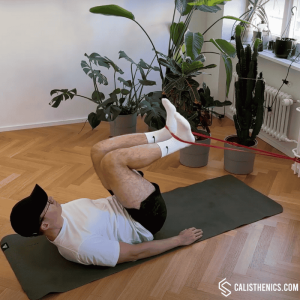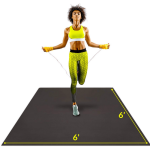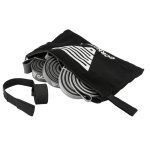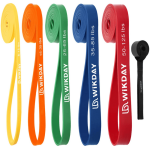In-and-Outs with Resistance Band
How to do In-and-Outs with Resistance Band?
In-and-outs with a resistance band are a core-focused exercise that targets the lower abdominals, hip flexors, and quads. In this movement, the athlete lies on their back with a resistance band anchored to a stable point and wrapped around their ankles. By pulling their knees toward the chest and then extending the legs back out, the exercise challenges the core and hip flexors while engaging the legs against the band’s resistance. This exercise is ideal for building core stability, improving lower body strength, and enhancing endurance.
Steps to Perform a Proper In-and-Out with Resistance Band:
1. Anchor the Resistance Band:
• Secure a resistance band to a stable anchor point (such as a door anchor or heavy object) behind you.
• Lie flat on your back with your head facing away from the anchor, ensuring the band is taut.
2. Place the Band Around Your Ankles:
• Loop the ends of the band around each ankle. Position yourself far enough from the anchor point so that the band has some tension when your legs are fully extended.
3. Engage Your Core and Lift Your Legs:
• Lift your legs a few inches off the ground to engage your core. You can place your hands on the floor beside you or under your glutes for support.
• Keep your head and neck relaxed, resting on the floor, and tighten your core to prevent your lower back from arching.
4. Pull Your Knees Toward Your Chest:
• Exhale as you bend your knees and pull them toward your chest, using your core and hip flexors to control the movement. Avoid using momentum.
• Keep your lower back pressed against the floor and focus on keeping your core tight.
5. Extend Your Legs Back Out:
• Inhale as you slowly extend your legs back out, straightening them to the starting position while maintaining control and tension in the resistance band.
• Stop just before your legs are fully extended to keep constant tension on the core and prevent your lower back from arching.
6. Repeat the Movement:
• Perform the desired number of repetitions, focusing on smooth, controlled movements and maintaining core engagement throughout each rep.
Benefits of In-and-Outs with Resistance Band
• Strengthens the Core: This exercise primarily targets the rectus abdominis and lower abs, helping to build core strength and endurance.
• Enhances Hip Flexor Strength: In-and-outs with a resistance band strengthen the hip flexors, which are essential for stability and mobility in daily activities and athletic movements.
• Improves Lower Body Strength: The quadriceps and glutes are engaged to stabilize the legs against resistance, building lower body strength and endurance.
• Builds Functional Core Stability: By focusing on controlled leg movements, this exercise improves functional core stability, which is essential for balance, coordination, and proper posture.
• Portable and Convenient: Resistance bands are lightweight and portable, making this exercise easy to perform at home, in the gym, or while traveling.
• Great for Lower Ab Engagement: In-and-outs effectively target the lower abdominals, which are often difficult to isolate, making this exercise beneficial for complete core development.
• Low Impact on Joints: This exercise is low-impact and easy on the joints, making it suitable for individuals recovering from injury or looking for a gentler core workout.
Common Mistakes to Avoid
• Arching the Lower Back: Avoid allowing your lower back to lift off the floor, which can strain the lower back. Keep your core tight and your back pressed firmly against the floor.
• Using Momentum: Focus on slow, controlled movements rather than using momentum to bring your knees in. This maximizes core engagement and reduces the risk of strain.
• Fully Extending the Legs: Avoid locking out your knees at the end of each rep. Keep a slight bend to maintain continuous tension on the core and prevent lower back strain.
• Anchoring the Band Incorrectly: Ensure the resistance band is securely anchored to prevent it from slipping or shifting during the exercise.
• Not Engaging the Core: Failing to engage the core reduces the effectiveness of the exercise and increases the risk of lower back discomfort. Keep your core tight and engaged throughout the movement.
Tips for the proper execution of In-and-Outs with Resistance Band
Maintain a Neutral Spine: Press your lower back firmly against the floor to prevent arching, which can reduce core engagement and strain the lower back.
Engage Your Core: Keep your core tight to stabilize your torso and prevent your lower back from lifting off the floor.
Controlled Movements: Avoid using momentum to pull your knees in. Perform the exercise slowly and with control to maximize core engagement.
Breathing: Exhale as you pull your knees in and inhale as you extend your legs out. Steady breathing helps maintain rhythm and core stability.
Adjust the Distance: If the resistance band feels too tight or too loose, adjust your distance from the anchor point to ensure proper tension throughout the movement.
Muscles worked when doing In-and-Outs with Resistance Band
Primary Muscles:
•Abdominals: The rectus abdominis, especially the lower abs, are heavily engaged to control the inward and outward movement.
•Hip Flexors: The hip flexors assist in pulling the knees toward the chest, especially as you work against the resistance of the band.
Secondary Muscles:
•Quadriceps: The front of the thighs work to extend and stabilize the legs, particularly when straightening them against the band’s resistance.
•Obliques: Engage to stabilize the torso and prevent any rotation or tilting during the movement.
•Lower Back: The erector spinae muscles help maintain a stable spine and prevent arching of the lower back.
•Glutes: Engage slightly to assist with leg stability and hip movement during the extension phase.
Primary Muscle(s):
Secondary Muscle(s):
Adjust the difficulty of In-and-Outs with Resistance Band
How to make In-and-Outs with Resistance Band harder?
How to make In-and-Outs with Resistance Band easier?
How to make In-and-Outs with Resistance Band harder?
To make In-and-Outs with Resistance Band harder:
-
Use a Heavier Resistance Band: Increase the challenge by using a band with more resistance, requiring more effort from your core and hip flexors.
-
Hold at the Inward Position: Pause for 2-3 seconds with your knees close to your chest to increase time under tension and further engage the core.
-
Add a Crunch: At the top of each rep, perform a small crunch by lifting your head and shoulders off the floor to intensify core engagement.
How to make In-and-Outs with Resistance Band easier?
To make In-and-Outs with Resistance Band easier:
-
Use a Lighter Resistance Band: Start with a band that provides less resistance, making it easier to control the movement and maintain proper form.
-
Limit the Range of Motion: Instead of fully extending your legs, extend them only partway to reduce the intensity while still working the core.
-
Perform Fewer Repetitions: Start with a smaller number of repetitions (e.g., 8-10) and increase gradually as your strength and endurance improve.






